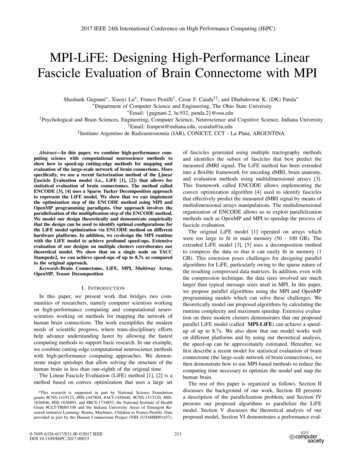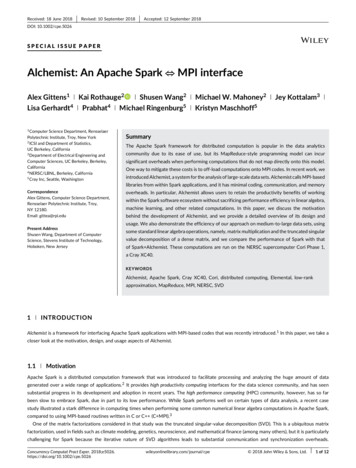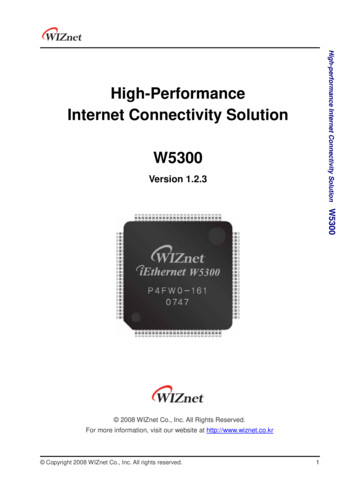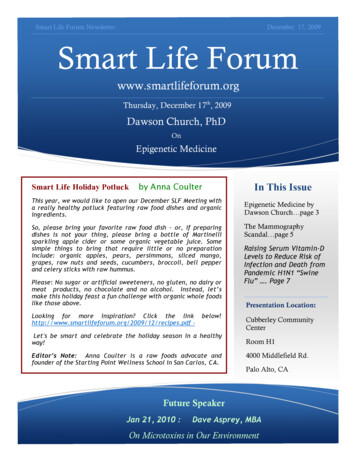
Transcription
2017 IEEE 24th International Conference on High Performance Computing (HiPC)MPI-LiFE: Designing High-Performance LinearFascicle Evaluation of Brain Connectome with MPIShashank Gugnani , Xiaoyi Lu , Franco Pestilli† , Cesar F. Caiafa†‡ , and Dhabaleswar K. (DK) Panda Department of Computer Science and Engineering, The Ohio State University Email: {gugnani.2, lu.932, panda.2}@osu.edu† Psychological and Brain Sciences, Engineering, Computer Science, Neuroscience and Cognitive Science, Indiana University† Email: franpest@indiana.edu, ccaiafa@iu.edu‡ Instituto Argentino de Radioastronomı́a (IAR), CONICET, CCT - La Plata, ARGENTINAof fascicles generated using multiple tractography methodsand identifies the subset of fascicles that best predict themeasured dMRI signal. The LiFE method has been extendedinto a flexible framework for encoding dMRI, brain anatomy,and evaluation methods using multidimensional arrays [3].This framework called ENCODE allows implementing theconvex optimization algorithm [4] used to identify fasciclesthat effectively predict the measured dMRI signal by means ofmultidimensional arrays manipulations. The multidimensionalorganization of ENCODE allows us to exploit parallelizationmethods such as OpenMP and MPI to speedup the process offascicle evaluation.The original LiFE model [1] operated on arrays whichwere too large to fit in main memory (50 - 100 GB). Theextended LiFE model [3], [5] uses a decomposition methodto compress the data so that it can easily fit in memory (1GB). This extension poses challenges for designing parallelalgorithms for LiFE, particularly owing to the sparse nature ofthe resulting compressed data matrices. In addition, even withthe compression technique, the data sizes involved are muchlarger than typical message sizes used in MPI. In this paper,we propose parallel algorithms using the MPI and OpenMPprogramming models which can solve these challenges. Wetheoretically model our proposed algorithms by calculating theruntime complexity and maximum speedup. Extensive evaluation on three modern clusters demonstrates that our proposedparallel LiFE model (called MPI-LiFE) can achieve a speedup of up to 8.7x. We also show that our model works wellon different platforms and by using our theoretical analysis,the speed-up can be approximately estimated. Hereafter, wefirst describe a recent model for statistical evaluation of brainconnectome (the large-scale network of brain connections), wethen demonstrate how to use MPI-based methods to reduce thecomputing time necessary to optimize the model and map thehuman brain.The rest of this paper is organized as follows. Section IIdiscusses the background of our work, Section III presentsa description of the parallelization problem, and Section IVpresents our proposed algorithms to parallelize the LiFEmodel. Section V discusses the theoretical analysis of ourproposed model, Section VI demonstrates a performance eval-Abstract—In this paper, we combine high-performance computing science with computational neuroscience methods toshow how to speed-up cutting-edge methods for mapping andevaluation of the large-scale network of brain connections. Morespecifically, we use a recent factorization method of the LinearFascicle Evaluation model (i.e., LiFE [1], [2]) that allows forstatistical evaluation of brain connectomes. The method calledENCODE [3], [4] uses a Sparse Tucker Decomposition approachto represent the LiFE model. We show that we can implementthe optimization step of the ENCODE method using MPI andOpenMP programming paradigms. Our approach involves theparallelization of the multiplication step of the ENCODE method.We model our design theoretically and demonstrate empiricallythat the design can be used to identify optimal configurations forthe LiFE model optimization via ENCODE method on differenthardware platforms. In addition, we co-design the MPI runtimewith the LiFE model to achieve profound speed-ups. Extensiveevaluation of our designs on multiple clusters corroborates ourtheoretical model. We show that on a single node on TACCStampede2, we can achieve speed-ups of up to 8.7x as comparedto the original approach.Keywords-Brain Connectome, LiFE, MPI, Multiway Array,OpenMP, Tensor DecompositionI. I NTRODUCTIONIn this paper, we present work that bridges two communities of researchers, namely computer scientists workingon high-performance computing and computational neuroscientists working on methods for mapping the network ofhuman brain connections. The work exemplifies the modernneeds of scientific progress, where trans-disciplinary effortshelp advance understanding faster by allowing the fastestcomputing methods to support basic research. In our example,we combine cutting-edge computational neuroscience methodswith high-performance computing approaches. We demonstrate major speedups that allow solving the structure of thehuman brain in less than one-eighth of the original time.The Linear Fascicle Evaluation (LiFE) method [1], [2] is amethod based on convex optimization that uses a large set*This research is supported in part by National Science Foundationgrants #CNS-1419123, #IIS-1447804, #ACI-1450440, #CNS-1513120, #IIS1636846, #IIS-1636893, and #BCS-1734853, the National Institute of HealthGrant #ULT-TR001108 and the Indiana University Areas of Emergent Research initiative Learning: Brains, Machines, Children to Franco Pestilli. Dataprovided in part by the Human Connectome Project (NIH 1U54MH091657).0-7695-6326-0/17/ 31.00 2017 IEEEDOI 10.1109/HiPC.2017.00033213
signal by means of multidimensional arrays manipulations. Asa result of the multidimensional organization of ENCODE,we can exploit parallelization methods such as OpenMP andMPI to speedup the process of Fascicle Evaluation. Hereafterwe demonstrate striking results with speedups up to 8.7x thatcombine ENCODE and MVAPICH2. Before that, we brieflyintroduce the MVAPICH2 MPI library.uation of our proposed design, and Section VII discussesrelated work. Finally, Section VIII concludes the work.II. BACKGROUNDA. Statistical Evaluation of Brain ConnectomesDiffusion-weighted MRI (dMRI) data and computationaltractography methods allow the estimation of the macroscopicstructure of the brain connections in living human brains.dMRI measures the diffusion of water molecules along different spatial directions within the brain tissue. Diffusion isstrongest in the direction of the neuronal fiber bundles, this signal can be used to reconstruct the three-dimensional structureof the neuronal axons within the brain tissue by using computational tractography. Brain connections are reconstructed assets of fascicles, namely the Brain Connectome (see Figure 1),describing the putative position and orientation of the neuronalaxons bundles wrapped by myelin sheaths traveling within thebrain [6], [7], [8], [9]. Since dMRI provides only indirect measurements of the brain tissue organization and tractography isa stochastic computational method, the anatomical propertiesof the putative fascicles estimated with these methods candepend on data type, tractography algorithm, and parameterssettings [1], [2], [10]. For this reason, investigators have beendeveloping methods for results validation based on statisticaland computational approaches [11], [8], [12], [13].B. MVAPICH2MVAPICH2 [15] is an open-source implementation ofthe MPI-3.1 specification over modern high-end computingsystems and servers using InfiniBand, Omni-Path, Ethernet/iWARP, and RDMA over Converged Ethernet (RoCE)networking technologies. The MVAPICH2 software packagesare being used by more than 2,825 organizations worldwide in85 countries and are powering some of the top supercomputing centers in the world, including the 1st, 10,649,600-core(Sunway TaihuLight) at National Supercomputing Center inWuxi, China, the 15th Pleiades at NASA, the 20th Stampedeat TACC, and the 44th Tsubame 2.5 at Tokyo Institute ofTechnology. MVAPICH2 is also being distributed by manyInfiniBand, Omni-Path, iWARP, and RoCE vendors in theirsoftware distributions. MVAPICH2 has multiple derivativepackages, which provide support for hybrid MPI PGAS(CAF, UPC, and OpenSHMEM) programming models withunified communication runtime (i.e., MVAPICH2-X), optimized MPI communication for clusters with NVIDIA GPUs(i.e., MVAPICH2-GDR) and Intel MIC (i.e., MVAPICH2MIC), high-performance and scalable MPI communication forhypervisor- and container-based HPC cloud (i.e., MVAPICH2Virt), and energy aware and high-performance MPI communication (i.e., MVAPICH2-EA). In this paper, we primarilyuse the standard MVAPICH2 library to parallelize the LiFEcode with the MPI programming model to obtain optimizedperformance on supercomputers with InfiniBand and OmniPath networks.SymbolNθNvNfNnpFigure 1. The Brain Connectome. Illustration of a set of fascicles (whitematter bundles) obtained by using a tractography algorithm. Fascicles aregrouped together conforming white matter tracts (shown with different colorshere) connecting different cortical areas of the human brain.DescriptionNumber of diffusion directionsNumber of voxelsNumber of fasciclesNumber of nodes in connectomeNumber of MPI processesTable IN OTATIONRecently, linear methods based on convex optimization havebeen proposed for connectome evaluation [1], [2] and simultaneous connectome and white matter microstructure estimation[14]. The Linear Fascicle Evaluation method (LiFE; [1], [2]),uses a large set of putative fascicles generated by using multiple tractography methods (called candidate connectome) andidentifies the subset of fascicles that best predict the measureddMRI signal using convex optimization. The LiFE methodwas recently extended into a flexible framework for encodingdMRI, brain anatomy and evaluation methods using multidimensional arrays [3]. The framework called ENCODE allowsto implement the convex optimization algorithm [4] used toidentify fascicles that effectively predict the measured dMRIIII. D ESCRIPTION OF PARALLELIZATION P ROBLEMTable I describes the commonly used symbols in this paperand this section in particular. The LiFE model [1] can beexpressed using the following equation:y M w,(1)is a vector which contains the demeanedwhere y Rsignals for all white-matter voxels (v) across all diffusiondirections (θ). M RNθ Nv Nf is a matrix, which at columnf contains the signal contribution given by fascicle f at voxelNθ Nv214
v across all directions θ, and w RNf contains the weightsfor each fascicle in the connectome. The estimation of theseweights requires solving the the following non-negative leastsquare constrained optimization problem: 12min y M w subject to wf 0, f.(2)w2PlatformCluster ACluster C(3)(4)Nθ Nvis the matrix version of vector y. Bywhere Y Remploying the Sparse Tucker Decomposition, we getM Φ 1 D 2 S0 ,In this section, we propose high-performance parallel designs to accelerate the computation of the optimization algorithm used in the LiFE model. We specifically use the MPI andOpenMP programming models to compute the multiplicationof large sparse multiway arrays. The two main operations to beparallelized are y M w and w M T y. We present designsto accelerate both of these operations. We theoretically analyzeour proposed designs and show how this analysis can be usedto predict the optimal configuration to run LiFE on differentplatforms.(5)(6)Φ is sparse, which results in strong data compression.Solving the optimization problem (Equation 2) requiresthe use of Non-Negative Least Squares (NNLS) optimizationalgorithms. These algorithms require the iterative computationof two basic operations (y M w and w M T y). Since wenever explicitly store the matrix M , but rather its STD, thecomputation of the two basic operations requires the use ofmultiway arrays. y M w can be computed using Equation 6,while w M T y can be computed as follows:w Φ(3) vec(DT Y S0 )w MT y29.21%19.56%IV. P ROPOSED D ESIGNwhere the 3-way array Φ RNa Nv Nf has matrices Φv RNa Nf as lateral slices and S0 diag(S0 (1), S0 (2), ., S0 (Nv )) RNv Nv is a diagonal matrix with values S0 (v) along the main diagonal. By combiningEquations 4 and 5, the following decomposition is obtained:Y Φ 1 D 2 S0 3 w T .y Mw63.31%72.95%the data, and 5% of the time is spent solving the optimizationalgorithm. A similar trend is observed on cluster C. Thus,it is clear that multiway array multiplication is the mainbottleneck in the LiFE model and offers the most opportunityfor parallelization. This parallelization poses a challenge dueto the large sizes and sparse nature of the arrays as well as datadependencies in the computation of the array multiplication.For example, with the dataset we used for evaluation, the sizeof matrix D is 94.65 MB and matrix Y is 149.46 MB. Giventhese sizes, the MapReduce [18] paradigm seems to be a goodparallelization choice, however, given the iterative nature ofthe optimization algorithm, this choice is clearly the wrongway to proceed. While MPI is usually not used for messagesizes of this nature, we argue that it fits our requirements.MPI is designed for performance and flexibility. The uniquecomputational nature of the LiFE model can be accuratelycaptured and parallelized using MPI. We thus select the MPIprogramming paradigm to design a parallel algorithm for theLiFE model. We describe our proposed design to parallelizethe LiFE model in the next section.where G RR1 R2 R3 is the sparse core array and An RIn Rn are the factor matrices. The decomposition does notguarantee a good approximation. However, it compresses thedata because the core array is very sparse.M is a very large block-sparse matrix (M RNθ Nv Nf )which can be converted to a multiway array by using diffusiondirections (θ), voxels (v), and fascicles (f ) as the dimensionsof a 3D multiway array M RNθ Nv Nf . By representing Mas a multiway array, we can use the STD to compress its size.The original LiFE equation can then be rewritten as follo
In addition, we co-design the MPI runtime with the LiFE model to achieve profound speed-ups. Extensive evaluation of our designs on multiple clusters corroborates our theoretical model. We show that on a single node on TACC Stampede2, we can achieve speed-ups of up to 8.7x as compared to the original approach. Keywords-Brain Connectome, LiFE, MPI, Multiway Array, OpenMP, Tensor











